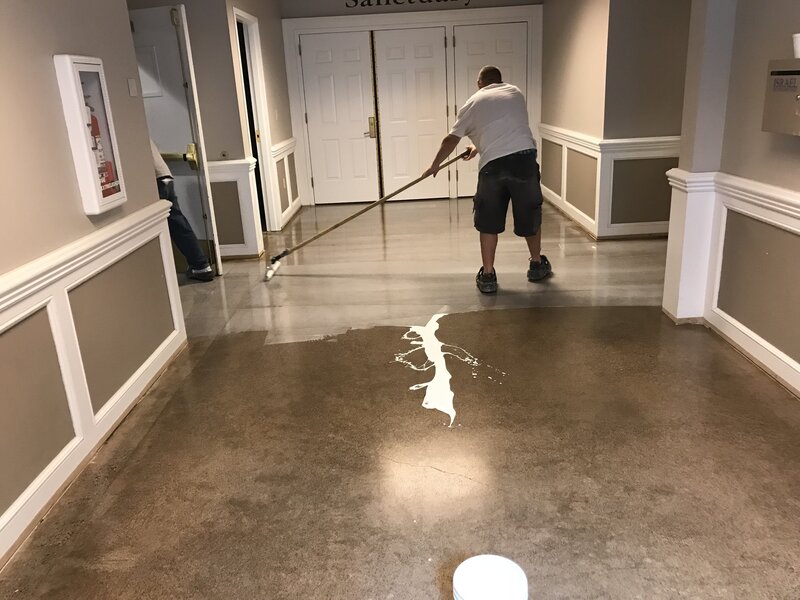The Importance of Staining and Sealing Garage Floors
Aesthetic Enhancement
One of the main benefits of staining your garage floor is the instant boost it provides to the overall look of the space. Stains can give concrete a rich, premium appearance, mimicking the looks of more expensive flooring options like marble or stained wood. With a range of colors and styles to choose from, garage floor stains can help you customize your garage to match the rest of your home’s aesthetic.
Durability and Longevity
Stains and sealers also play a critical role in enhancing the durability of your garage floor. These products create a barrier between the concrete and potential sources of damage, like automotive fluids, heavy equipment, or high foot traffic. This barrier can help prevent cracks, chips, and other signs of wear, extending the lifespan of your garage floor.
Moisture and Stain Protection
Concrete is a porous material, which means it can absorb liquids and stains easily. By using a stain and sealer, you can protect the floor from oil and chemical spills, making cleanup a breeze. Furthermore, sealers can prevent moisture from seeping into the concrete, reducing the risk of mold growth and potential damage from freeze-thaw cycles in colder climates.
Popular Stain and Sealer Options
Several types of garage floor stains and sealers are available on the market, each with pros and cons.
Acid Stains
Acid-based stains react chemically with the concrete to form a unique, multi-tonal effect. They are durable and fade-resistant but require careful handling due to their corrosive nature.
Water-Based Stains
Water-based stains are safer and easier to apply than acid stains. They provide a more uniform color and can be easily layered to achieve the desired depth of color. However, they may not be as long-lasting as acid stains.
Acrylic Sealers
Acrylic sealers are affordable, easy to apply, and offer good protection against water and oil stains. They’re available in both water-based and solvent-based forms. However, they may require reapplication more often than other types of sealers.
Epoxy Sealers
Epoxy sealers form a strong, durable coating that protects against stains and chemicals. They can also fill in small cracks and imperfections in the concrete. The downside is that they can be challenging to apply correctly and may become yellow over time under UV light.
Polyurethane Sealers
Polyurethane sealers provide a high-gloss finish and superior protection against chemicals and abrasion. They are UV-resistant, so they won’t yellow over time. However, they are more expensive and require precise application.
Tips for Applying Stains and Sealers
Surface Preparation
Proper surface preparation is crucial for the successful application of stains and sealers. The concrete should be clean, dry, and free from existing sealers or coatings. You may need to use a concrete grinder or a chemical stripper for thorough preparation.
Safety Precautions
Always follow safety guidelines when applying stains and sealers. Wear protective clothing, including gloves and safety glasses, and ensure adequate ventilation. Acid stains, in particular, require careful handling due to their corrosive nature.
Testing and Application
Before you apply the stain to the entire floor, test it on a small, inconspicuous area to ensure the desired color and effect. Apply the stain evenly using a sprayer, roller, or brush, and follow up with a sealer after the stain has fully dried.
Maintenance
Even with a sealer, your stained garage floor will require regular maintenance. Sweep or vacuum the floor regularly to remove dust and debris, and clean up spills promptly to prevent staining. Reapply the sealer as needed to maintain its protective qualities.
Garage floor stains and sealers can significantly enhance the aesthetics and longevity of your garage floor. Whether you choose an acid stain for its unique look, an epoxy sealer for its superior protection, or any other option, the key to a successful application lies in proper preparation, careful application, and regular maintenance. With these steps, you can enjoy a beautiful, durable garage floor for many years to come.
Key Takeaways:
- Garage floor stains and sealers offer both aesthetic enhancement and critical protection against damage, extending the lifespan of your garage floor.
- Stains can transform the look of dull concrete into a high-end finish, mimicking marble or stained wood, and provide customization options.
- Sealers offer a barrier against damage sources such as automotive fluids, heavy equipment, high foot traffic, and moisture.
- Acid-based stains provide a unique, multi-tonal effect and are durable and fade-resistant but require careful handling due to their corrosive nature.
- Water-based stains are safer, easier to apply, and offer a more uniform color but may not be as long-lasting as acid stains.
- Acrylic sealers are affordable and easy to apply but may require frequent reapplication.
- Epoxy sealers form a strong, durable coating and can fill in small cracks, but they can be challenging to apply and may become yellow over time.
- Polyurethane sealers offer superior protection, a high-gloss finish, and UV resistance but are more expensive and require precise application.
- Successful stain and sealer application requires thorough surface preparation, safety precautions, testing on a small area before full application, and regular maintenance after application.


Recent Comments